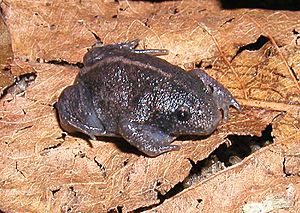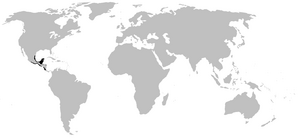Mexican Burrowing Toad facts for kids
Quick facts for kids Mexican Burrowing Toad |
|
|---|---|
 |
|
| Juvenile | |
| Conservation status | |
| Scientific classification | |
| Kingdom: | |
| Phylum: | |
| Class: | |
| Order: | |
| Suborder: | |
| Family: |
Rhinophrynidae
Günther, 1859
|
| Genus: |
Rhinophrynus
Duméril & Bibron, 1841
|
| Species: |
R. dorsalis
|
| Binomial name | |
| Rhinophrynus dorsalis Duméril & Bibron, 1841
|
|
 |
|
| Distribution of R. dorsalis (in black) | |
The Mexican burrowing toad (Rhinophrynus dorsalis) is a special kind of frog. It's the only species in its group, called Rhinophrynus, and its family, called Rhinophrynidae.
You can find these toads in places like southern Texas, Mexico, and other Central American countries such as Guatemala, Honduras, El Salvador, Nicaragua, and Costa Rica. Long ago, similar toads lived much further north, even in Canada. But those types are now extinct.
Contents
What Does the Mexican Burrowing Toad Look Like?
The Mexican Burrowing Toad can grow up to 8 cm (3.1 in) long. It often has red spots on its round body. A red stripe usually runs down the middle of its back.
It has short legs and a small, pointy head. Its feet have tough, shovel-like parts. These help it dig into the ground. Its eyes are quite small. Unlike most frogs, its tongue shoots straight out from the front of its mouth. Other frogs usually flip their tongues out.
How Does the Mexican Burrowing Toad Behave?
As its name tells you, the Mexican Burrowing Toad loves to dig! It spends a lot of its life underground. This helps it stay safe and cool.
After a big rain, these toads come out from the soil. They travel up to 1.6 km (1.0 mi) to find a good water source. There, they lay their eggs. Because rain can be unpredictable, they might call and mate at any time of the year. Once the land dries up, the toad digs back into the soft soil using its short, strong legs.
Life Cycle of the Mexican Burrowing Toad
The egg and tadpole stages of this toad's life are very quick. The eggs hatch in just a few days. The tadpoles grow into young toads in about one to three months.
What Does the Mexican Burrowing Toad Eat?
The Mexican Burrowing Toad mainly eats insects. Its favorite foods are ants and termites.
Sounds and Defense
When the toad calls, it makes a loud, low sound like "wh-o-o-o-a". If it's calling or feels scared, its body gets very big and puffy. This makes it look larger to scare away predators.
Images for kids
See also
 In Spanish: Sapo cavador para niños
In Spanish: Sapo cavador para niños



